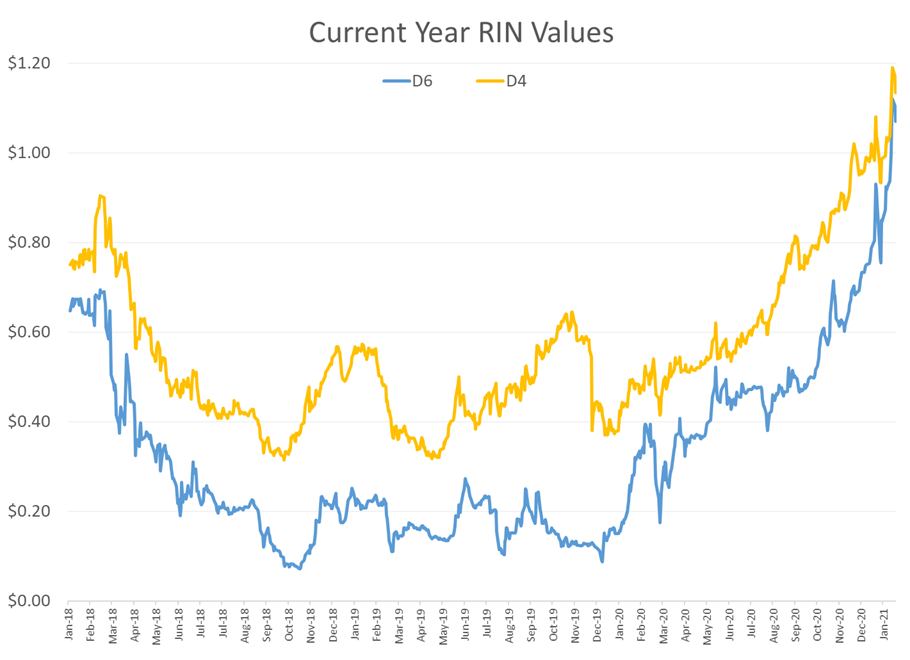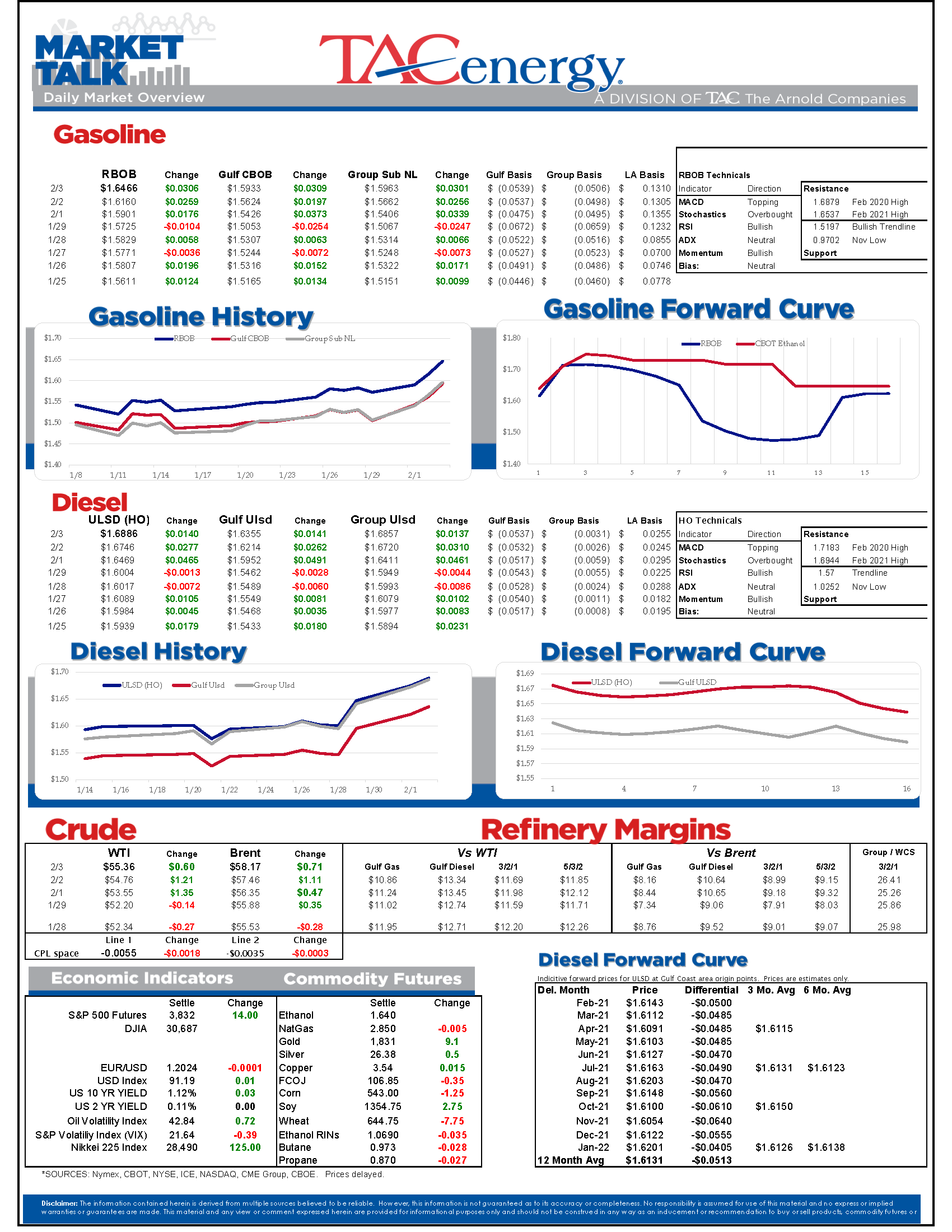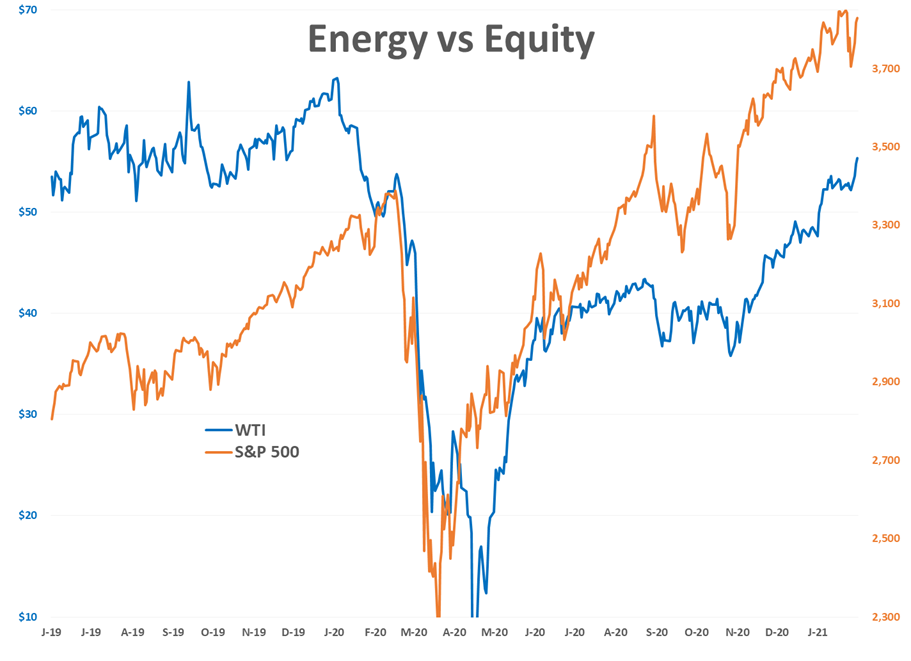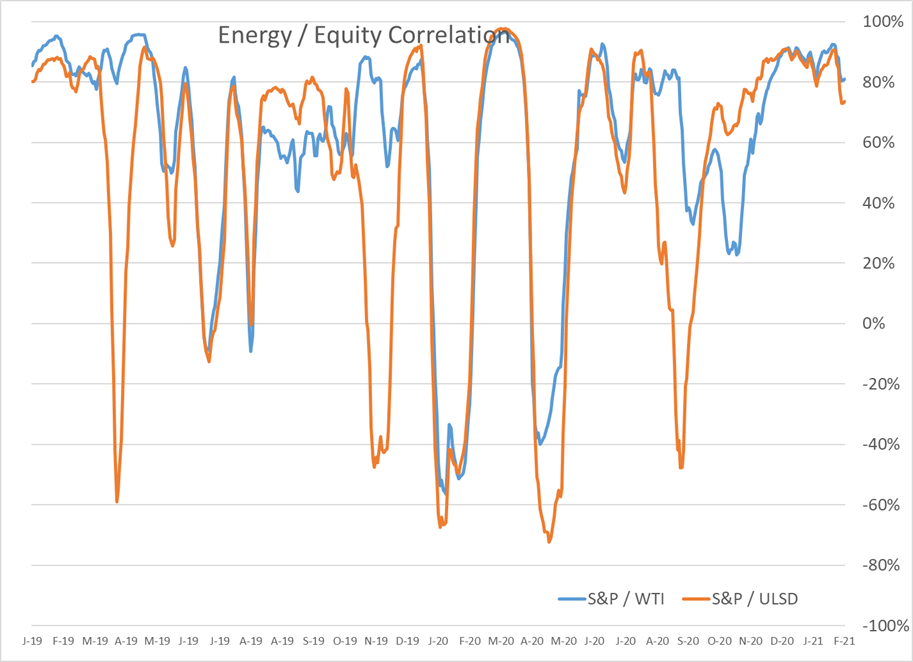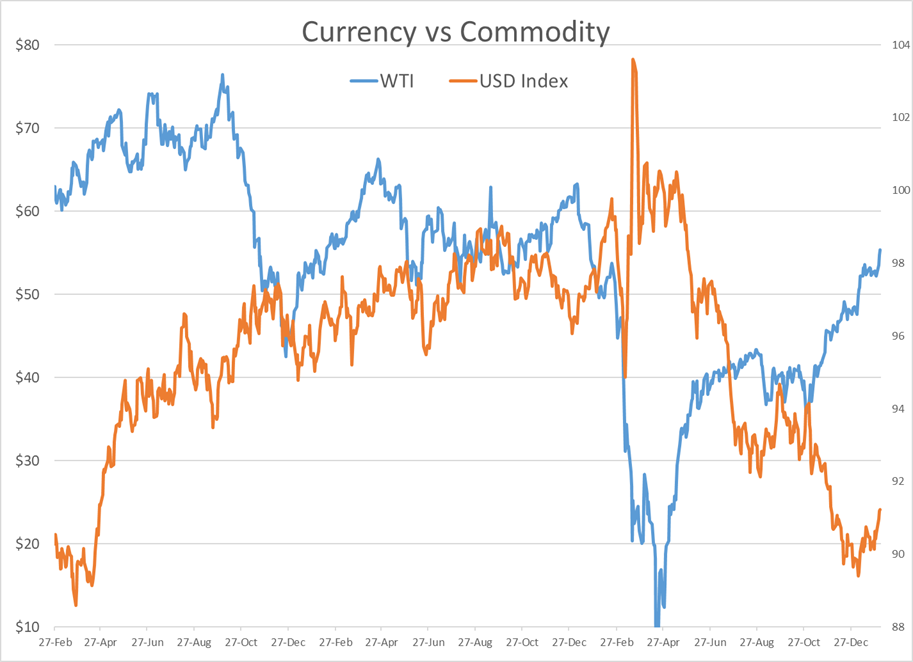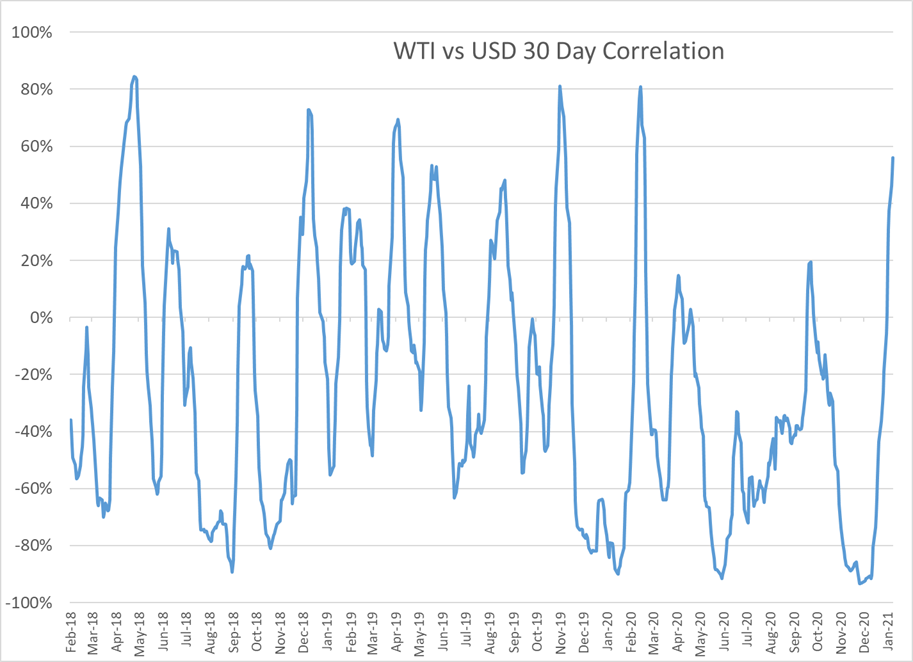Oil Prices Trade At Highest Values In Over A Year

Oil prices are trading at their highest values in more than a year this morning, and refined products are nearing one year highs of their own in what appears to be a technically driven rally after prices bounced hard off of the bullish trend lines Monday, and broke through chart resistance yesterday.
A decline in oil inventories reported by the API is getting some of the credit for the continued rally, with the industry group reporting a 4.3 million barrel draw in crude stocks. Gasoline and diesel stocks had smaller declines of 240,000 and 1.6 million barrels respectively. One thing to watch out for is that we saw a huge draw in last week’s DOE report largely driven by a surge in exports and decline in imports. If those trade flows normalize this week, we could see a large build in crude stocks that might throw a little cold water on the bulls.
One odd thing about this rally is that it’s happening despite a strong move higher in the U.S. Dollar, which typically would put downward pressure on commodities in general, and energy contracts in particular. The correlation between the currency and energy contracts has flipped to positive in recent weeks, another sign that the most recent runup may be more technical for energy than fundamental as buyers of U.S. dollar-denominated oil are now paying more for the product, and their exchange rate.
Another odd thing about this rally? It’s happening despite RIN values pulling back sharply, falling more than a dime from the multi-year highs they reached last week. RIN values and product prices often move in the same direction as the federal renewable fuel credits act like a tax to refiners who don’t have the capability to blend their own ethanol, bio and other renewable products, which means a rise in RIN prices requires a rise in crack spreads for the margins to stay even.
A third oddity about this rally is that it’s coming in the wake of a major winter storm that is hitting demand hard all along some of the country’s most populated areas on the east coast, while another major cold snap moves in right behind it that’s likely to further reduce consumption. Despite that, we’re seeing RBOB lead the move higher even as we could be in for the worst week of gasoline demand in some markets since Christmas.
The storm does not seem to have done any lasting damage to supply infrastructure in the North East, with no extended terminal or refinery downtime. In fact, it does not appear that there are any major refinery outages being reported that might cause the spike in RBOB outright prices and time spreads that we’re seeing this week. Actually, the only newsworthy refinery reports are that the refinery formerly known as Hovensa, is increasing its output, bringing a new competitor back to the Atlantic basin for the first time in years.
A strong recover rally in U.S. equity markets after some heavy selling last week seems to be adding to the bullish sentiment, but equities are pointing to a flat open so that doesn’t seem to explain the early strength in RBOB today.
Given the equity headlines over the past week, you might think that the RBOB rally could be a short squeeze, but since large speculators have actually been building their net long position to the highest level in a year over the past several weeks, that doesn’t seem to be a likely cause.
At this point, it doesn’t matter much what’s causing the rally to continue, until that bullish trend line is broken, it seems the path of least resistance is for energy prices to keep moving higher despite all the potential headwinds. The big test for RBOB and ULSD remains the February 2020 highs around $1.68 and $1.72. If the break there, we could see another 15-20 cents of upside, but a failure could mean a move back into the $1.40s based on nothing more than a natural technical correction of the three month old rally.
Click here to download a PDF of today's TACenergy Market Talk.
Latest Posts
Gasoline Futures Are Leading The Way Lower This Morning
The Sell-Off Continues In Energy Markets, RBOB Gasoline Futures Are Now Down Nearly 13 Cents In The Past Two Days
Week 15 - US DOE Inventory Recap
Prices To Lease Space On Colonial’s Main Gasoline Line Continue To Rally This Week
Social Media
News & Views
View All
Gasoline Futures Are Leading The Way Lower This Morning
It was a volatile night for markets around the world as Israel reportedly launched a direct strike against Iran. Many global markets, from equities to currencies to commodities saw big swings as traders initially braced for the worst, then reversed course rapidly once Iran indicated that it was not planning to retaliate. Refined products spiked following the initial reports, with ULSD futures up 11 cents and RBOB up 7 at their highest, only to reverse to losses this morning. Equities saw similar moves in reverse overnight as a flight to safety trade soon gave way to a sigh of relief recovery.
Gasoline futures are leading the way lower this morning, adding to the argument that we may have seen the spring peak in prices a week ago, unless some actual disruption pops up in the coming weeks. The longer term up-trend is still intact and sets a near-term target to the downside roughly 9 cents below current values. ULSD meanwhile is just a nickel away from setting new lows for the year, which would open up a technical trap door for prices to slide another 30 cents as we move towards summer.
A Reuters report this morning suggests that the EPA is ready to announce another temporary waiver of smog-prevention rules that will allow E15 sales this summer as political winds continue to prove stronger than any legitimate environmental agenda. RIN prices had stabilized around 45 cents/RIN for D4 and D6 credits this week and are already trading a penny lower following this report.
Delek’s Big Spring refinery reported maintenance on an FCC unit that would require 3 days of work. That facility, along with several others across TX, have had numerous issues ever since the deep freeze events in 2021 and 2024 did widespread damage. Meanwhile, overnight storms across the Midwest caused at least one terminal to be knocked offline in the St. Louis area, but so far no refinery upsets have been reported.
Meanwhile, in Russia: Refiners are apparently installing anti-drone nets to protect their facilities since apparently their sling shots stopped working.
Click here to download a PDF of today's TACenergy Market Talk.

The Sell-Off Continues In Energy Markets, RBOB Gasoline Futures Are Now Down Nearly 13 Cents In The Past Two Days
The sell-off continues in energy markets. RBOB gasoline futures are now down nearly 13 cents in the past two days, and have fallen 16 cents from a week ago, leading to questions about whether or not we’ve seen the seasonal peak in gasoline prices. ULSD futures are also coming under heavy selling pressure, dropping 15 cents so far this week and are trading at their lowest level since January 3rd.
The drop on the weekly chart certainly takes away the upside momentum for gasoline that still favored a run at the $3 mark just a few days ago, but the longer term up-trend that helped propel a 90-cent increase since mid-December is still intact as long as prices stay above the $2.60 mark for the next week. If diesel prices break below $2.50 there’s a strong possibility that we see another 30 cent price drop in the next couple of weeks.
An unwind of long positions after Iran’s attack on Israel was swatted out of the sky without further escalation (so far anyway) and reports that Russia is resuming refinery runs, both seeming to be contributing factors to the sharp pullback in prices.
Along with the uncertainty about where the next attacks may or may not occur, and if they will have any meaningful impact on supply, come no shortage of rumors about potential SPR releases or how OPEC might respond to the crisis. The only thing that’s certain at this point, is that there’s much more spare capacity for both oil production and refining now than there was 2 years ago, which seems to be helping keep a lid on prices despite so much tension.
In addition, for those that remember the chaos in oil markets 50 years ago sparked by similar events in and around Israel, read this note from the NY Times on why things are different this time around.
The DOE’s weekly status report was largely ignored in the midst of the big sell-off Wednesday, with few noteworthy items in the report.
Diesel demand did see a strong recovery from last week’s throwaway figure that proves the vulnerability of the weekly estimates, particularly the week after a holiday, but that did nothing to slow the sell-off in ULSD futures.
Perhaps the biggest next of the week was that the agency made its seasonal changes to nameplate refining capacity as facilities emerged from their spring maintenance.
PADD 2 saw an increase of 36mb/day, and PADD 3 increased by 72mb/day, both of which set new records for regional capacity. PADD 5 meanwhile continued its slow-motion decline, losing another 30mb/day of capacity as California’s war of attrition against the industry continues. It’s worth noting that given the glacial pace of EIA reporting on the topic, we’re unlikely to see the impact of Rodeo’s conversion in the official numbers until next year.
Speaking of which, if you believe the PADD 5 diesel chart below that suggests the region is running out of the fuel, when in fact there’s an excess in most local markets, you haven’t been paying attention. Gasoline inventories on the West Coast however do appear consistent with reality as less refining output and a lack of resupply options both continue to create headaches for suppliers.

